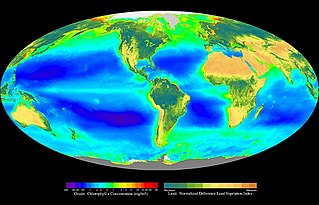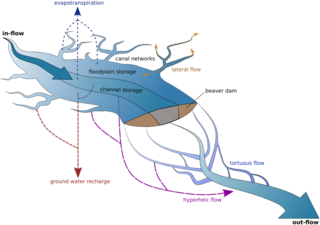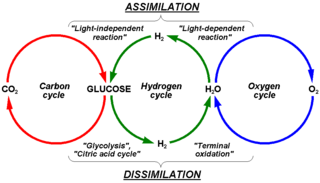
An ecosystem consists of all the organisms and the physical environment with which they interact. These biotic and abiotic components are linked together through nutrient cycles and energy flows. Energy enters the system through photosynthesis and is incorporated into plant tissue. By feeding on plants and on one another, animals play an important role in the movement of matter and energy through the system. They also influence the quantity of plant and microbial biomass present. By breaking down dead organic matter, decomposers release carbon back to the atmosphere and facilitate nutrient cycling by converting nutrients stored in dead biomass back to a form that can be readily used by plants and microbes.

Photosynthesis is a process used by plants and other organisms to convert light energy into chemical energy that, through cellular respiration, can later be released to fuel the organism's activities. Some of this chemical energy is stored in carbohydrate molecules, such as sugars and starches, which are synthesized from carbon dioxide and water – hence the name photosynthesis, from the Greek phōs, "light", and synthesis, "putting together". Most plants, algae, and cyanobacteria perform photosynthesis; such organisms are called photoautotrophs. Photosynthesis is largely responsible for producing and maintaining the oxygen content of the Earth's atmosphere, and supplies most of the energy necessary for life on Earth.

Limnology is the study of inland aquatic ecosystems. The study of limnology includes aspects of the biological, chemical, physical, and geological characteristics of fresh and saline, natural and man-made bodies of water. This includes the study of lakes, reservoirs, ponds, rivers, springs, streams, wetlands, and groundwater. Water systems are often categorized as either running (lotic) or standing (lentic).

In ecology, primary production is the synthesis of organic compounds from atmospheric or aqueous carbon dioxide. It principally occurs through the process of photosynthesis, which uses light as its source of energy, but it also occurs through chemosynthesis, which uses the oxidation or reduction of inorganic chemical compounds as its source of energy. Almost all life on Earth relies directly or indirectly on primary production. The organisms responsible for primary production are known as primary producers or autotrophs, and form the base of the food chain. In terrestrial ecoregions, these are mainly plants, while in aquatic ecoregions algae predominate in this role. Ecologists distinguish primary production as either net or gross, the former accounting for losses to processes such as cellular respiration, the latter not.

Energy flow is the flow of energy through living things within an ecosystem. All living organisms can be organized into producers and consumers, and those producers and consumers can further be organized into a food chain. Each of the levels within the food chain is a trophic level. In order to more efficiently show the quantity of organisms at each trophic level, these food chains are then organized into trophic pyramids. The arrows in the food chain show that the energy flow is unidirectional, with the head of an arrow indicating the direction of energy flow; energy is lost as heat at each step along the way.

C4 carbon fixation or the Hatch–Slack pathway is one of three known photosynthetic processes of carbon fixation in plants. It owes the names to the 1960s discovery by Marshall Davidson Hatch and Charles Roger Slack that some plants, when supplied with 14CO2, incorporate the 14C label into four-carbon molecules first.

Ecohydrology is an interdisciplinary scientific field studying the interactions between water and ecological systems. It is considered a sub discipline of hydrology, with an ecological focus. These interactions may take place within water bodies, such as rivers and lakes, or on land, in forests, deserts, and other terrestrial ecosystems. Areas of research in ecohydrology include transpiration and plant water use, adaption of organisms to their water environment, influence of vegetation and benthic plants on stream flow and function, and feedbacks between ecological processes, the soil carbon sponge and the hydrological cycle.

LI-COR Biosciences is an international biotech company which designs, manufactures, and markets instruments, measurement systems, and software for biological and environmental research, and develops relevant measurement methodologies and techniques.

Soil respiration refers to the production of carbon dioxide when soil organisms respire. This includes respiration of plant roots, the rhizosphere, microbes and fauna.

Ecosystem respiration is the sum of all respiration occurring by the living organisms in a specific ecosystem. The two main processes that contribute to ecosystem respiration are photosynthesis and cellular respiration. Photosynthesis uses carbon-dioxide and water, in the presence of sunlight to produce glucose and oxygen whereas cellular respiration uses glucose and oxygen to produce carbon-dioxide, water, and energy. The coordination of inputs and outputs of these two processes creates a completely interconnected system, constituting the underlying functioning of the ecosystems overall respiration.
Maintenance respiration refers to metabolism occurring in an organism that is needed to maintain that organism in a healthy, living state. Maintenance respiration contrasts with growth respiration, which is responsible for the synthesis of new structures in growth, nutrient uptake, nitrogen (N) reduction and phloem loading, whereas maintenance respiration is associated with protein and membrane turnover and maintenance of ion concentrations and gradients.

The carbon cycle is an essential part of life on Earth. About half the dry weight of most living organisms is carbon. It plays an important role in the structure, biochemistry, and nutrition of all living cells. Living biomass holds about 550 gigatons of carbon, most of which is made of terrestrial plants (wood), while some 1,200 gigatons of carbon are stored in the terrestrial biosphere as dead biomass.
John Albert Raven FRS FRSE is a British botanist, and emeritus professor at University of Dundee and the University of Technology Sydney. His primary research interests lie in the ecophysiology and biochemistry of marine and terrestrial primary producers such as plants and algae.
The CO2 fertilization effect or carbon fertilization effect causes an increased rate of photosynthesis while limiting leaf transpiration in plants. Both processes result from increased levels of atmospheric carbon dioxide (CO2). The carbon fertilization effect varies depending on plant species, air and soil temperature, and availability of water and nutrients. Net primary productivity (NPP) might positively respond to the carbon fertilization effect. Although, evidence shows that enhanced rates of photosynthesis in plants due to CO2 fertilization do not directly enhance all plant growth, and thus carbon storage. The carbon fertilization effect has been reported to be the cause of 44% of gross primary productivity (GPP) increase since the 2000s. Earth System Models, Land System Models and Dynamic Global Vegetation Models are used to investigate and interpret vegetation trends related to increasing levels of atmospheric CO2. However, the ecosystem processes associated with the CO2 fertilization effect remain uncertain and therefore are challenging to model.
Thomas D. Sharkey is a plant biochemist who studies gas exchange between plants and the atmosphere. His research has covered (1) carbon metabolism of photosynthesis from carbon dioxide uptake to carbon export from the Calvin-Benson Cycle, (2) isoprene emission from plants, and (3) abiotic stress tolerance. Four guiding questions are: (1) how leaf photosynthesis affects plant yield, (2) does some carbon fixation follow an oxidative pathway that reduces sugar output but stabilizes photosynthesis, (3) why plants make isoprene, and (4) how plants cope with high temperature.
Susan E. Trumbore is an earth systems scientist focusing on the carbon cycle and its effects on climate. She is a director at the Max Planck Institute for Biogeochemistry and a Professor of Earth System Science at University of California, Irvine. She is a fellow of the American Geophysical Union and the American Association for the Advancement of Science, a Member of the National Academy of Sciences and recipient of the Benjamin Franklin Medal.
Terence Vincent Callaghan is a British biologist specialized in the ecology of the Arctic. Much of his work on arctic plants has taken place in Abisko in northernmost Sweden, based at the Abisko Scientific Research Station where he served as director. He was a lead author of the IPCC Fourth Assessment Reports chapter on polar regions.

Net ecosystem production (NEP) in ecology, limnology, and oceanography, is the difference between gross primary production (GPP) and net ecosystem respiration. Net ecosystem production represents all the carbon produced by plants in water through photosynthesis that does not get respired by animals, other heterotrophs, or the plants themselves.
Beverly Law is professor emeritus at Oregon State University known for her research on forest ecosystems, especially with respect to carbon cycling, fire, and how human actions impact future climate.

Elise Gislaine Pendall is an American soil and ecosystem ecologist who is a professor at Western Sydney University. She studies how biogeochemical cycling responds to climate change and disturbances to the ecosystem.











